
Our headline a fortnight ago was “Recovery on the cards, but it will be hard work.” Albeit for unhappy reasons, the turnaround was much less hard work than we expected. The boiling up of tension in the Middle East has been the clear driver here as markets have gone firmly into “risk-off” mode, giving gold and silver a boost by association.
Immediate outlook
Gold is overbought at $2,000 and needs to correct; the medium-term range should remain unchanged with support at $1,900, while the upside is probably favored in the medium-term. Political tension affects gold directly and indirectly in these circumstances as a potential knock-on from its impact on monetary policy. Silver’s comparative underperformance underlines the political and economic risks adhering to the flare-up.
Conclusion
Both metals should now consolidate and unwind overbought positions; the relative moves between the two metals highlight the geopolitical and attendant economic risk of the current circumstances. For now, though, conditions need to settle down.
Gold and the 2-year and 10-year US Bond Rates
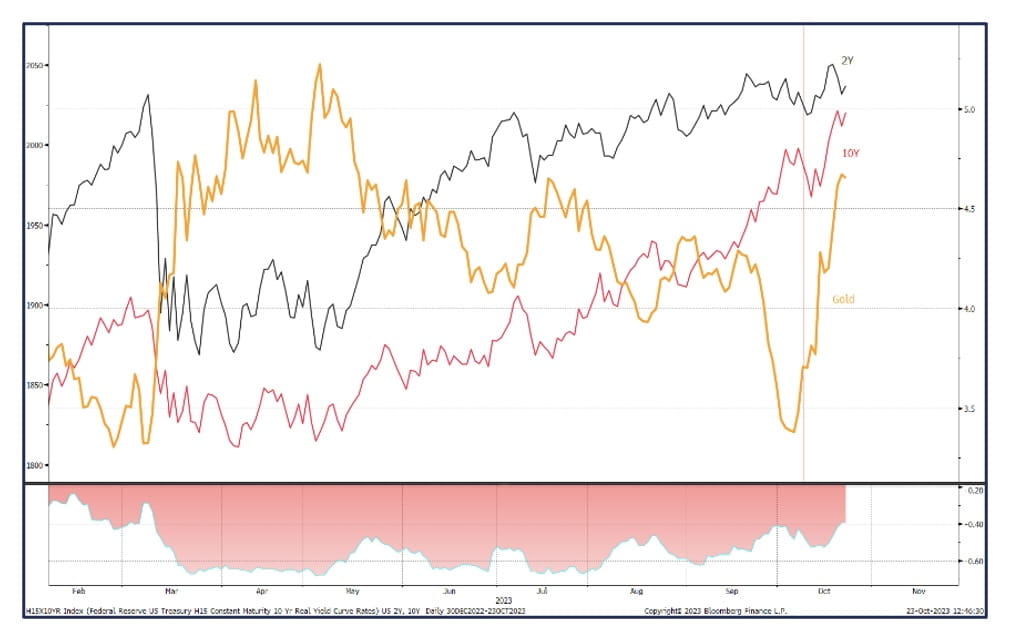
Source: Bloomberg, StoneX
As tensions flared initially, US Treasuries also saw some initial interest as a safe haven. However, the bond markets still appear to be more concerned with central bank policy. While policy rates may not rise much further, if at all in the current environment, quantitative tightening is still with us, and this is helping to keep rates supported, with the result that gold and US rates are all rising.
Central Banks gold-supportive by default
Now, it is axiomatic that the major central banks will have their eyes firmly on geopolitical tensions, both due to elevated risk and its potential impact on economic activity; there is, therefore, a “second-order” impact of the geopolitical developments on monetary policy. In this instance, while it is unlikely to mean rate cuts as that would be too soon and risk undoing the work that has been done thus far, it certainly does suggest that major central banks will be even more cautious than usual. So, this is another element that supports gold, based on geopolitical risk but via a circuitous route. We would note that the correlation between Gold and the VIX index has been positive since mid-October.
Gold and the VIX index
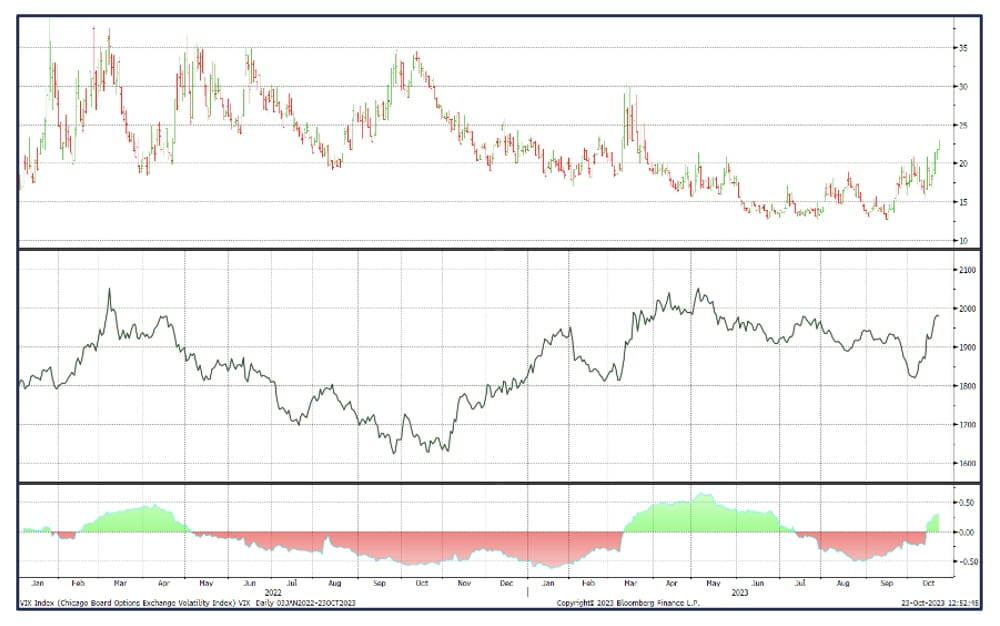
Source: Bloomberg, StoneX
Where there has been a sea-change, though, is that now the markets (not just the bond markets) do appear to have adjusted to “higher-for-longer,” and this has, to some degree, opened the path for gold to renew its role as a safe haven.
As we write, gold has tested the psychologically important $2,000 and has been found wanting, but this is not a surprise given the speed of its rise since early October. From the $1,811 low on 6th October, the day the market turned up, gold gained 10.3% to the high of $1,997 on 20th October before starting a mid-correction at the start of this week. If we return to the $2,063 high of 4th May, this recent run-up almost completed a Fibonacci 76.4% retracement.
Gold, silver, and the ratio
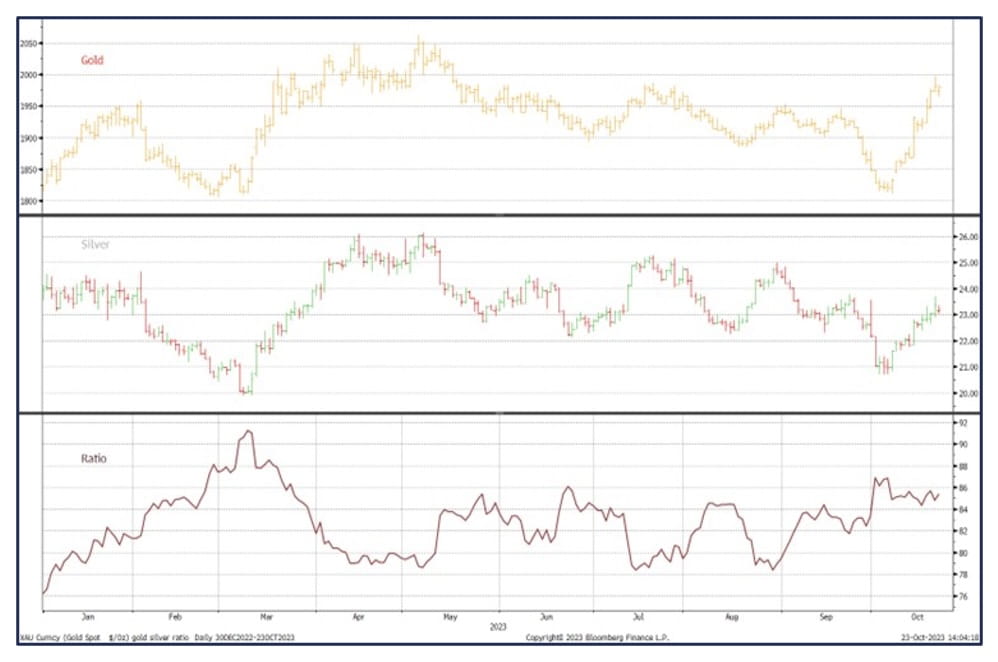
Source: Bloomberg, StoneX
Meanwhile, Silver managed only a 50% retracement in its rally compared with the 6th May high of $16.14, which ran up recently to $23.70 last Friday, 10th October. The recent rally, from $20.69, was 14.5%, a much lower beta than usual. Usually, when moves are fundamentally driven, a 10% move in gold would be expected to generate at least a 20% move in silver. The fact that it did not reflect the highly political element in this recent move.
Futures positions
On COMEX, both metals have seen fresh longs and reduced shorts among the Money Managers; over the past week, gold longs expanded by 34 tonnes or 12%, while silver shorts contracted by 97 tonnes or 2%. The net positions swung from a short of 83 tonnes to a net long of 47 tonnes. The outright longs in this sector, at 326 tonnes, are 9% lower than the twelve-month average.
Silver longs added 182 tonnes (4%) while shorts contracted by 1,146t tonnes or 21%, so the net position swung from a short of 795 tonnes to a long of 535 tonnes. At 4,988 tonnes, the outright longs are 20% below the twelve-month average.
So, neither of these can be described as having, on COMEX at least, a speculative overhang.
Gold COMEX positioning, Money Managers (tonnes)
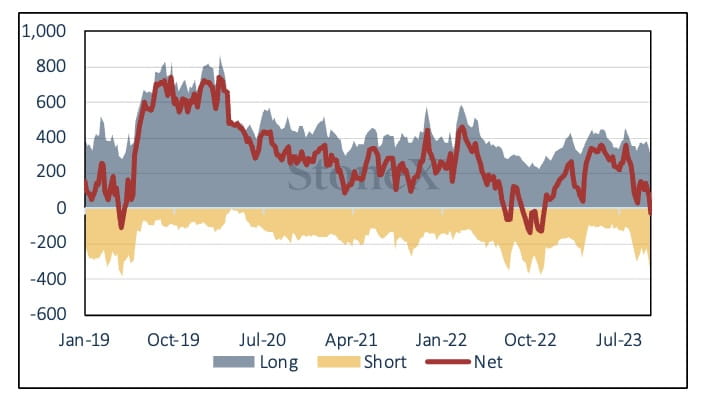
Source: CFTC, StoneX
COMEX Managed Money Silver Positioning (tonnes)
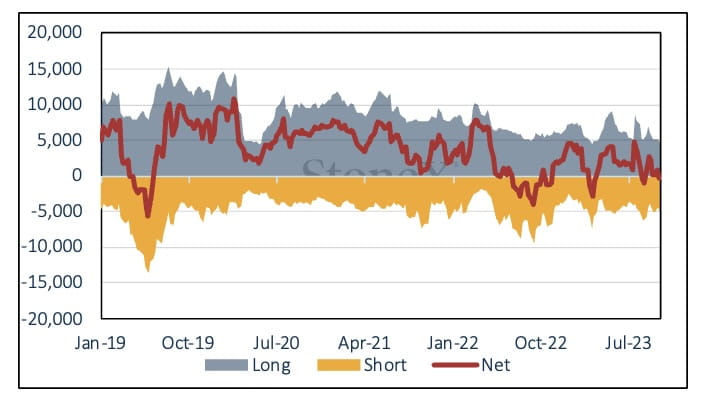
Source: CFTC, StoneX
Exchange Traded Products
In the ETP sector, gold has remained friendless despite the political turmoil, with only three days of net creation since the first attack; the story that the daily numbers tell is of selling into strength, with some of the highest net redemption days coming when the price was running hard. Since the start of October, the gold ETPs have lost a net 51 tonnes for a dollar outflow of $3.1Bn. Year to date, the net fall is 251 tonnes or $14.4Bn.
Silver is similar, with only two days of net creation over the same period. The net change since the start of October is a drop of 42 tonnes, as there had been some buying at the beginning of the month. The decline since the first reported attack was 325 tonnes, or just 1% of the underlying, to 22,168 tonnes (world mine production is ~26,500 tonnes per annum.
Taken from analysis by Rhona O’Connell, Head of Commodity Market Analysis for EMEA & Asia, StoneX Financial Ltd.
Contact: [email protected].





